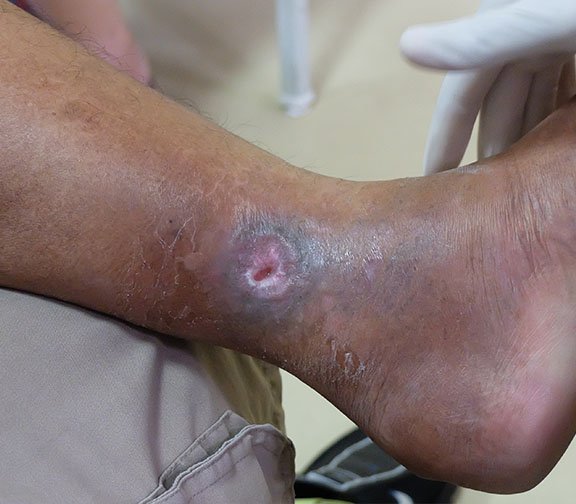Venous leg ulcers (VLUs) are chronic wounds that require specialized care to promote healing and prevent infections. These ulcers often result from poor circulation due to venous insufficiency, leading to swelling, pain, and slow healing. Proper wound management, including selecting the right wound dressing, is crucial in ensuring effective recovery.
Learn the basics: What Are Venous Leg Ulcers?
Understanding Venous Leg Ulcers
Venous leg ulcers develop when blood fails to circulate effectively in the lower legs, causing blood to pool and leading to increased pressure on the veins. Over time, this can cause the skin to break down, resulting in an ulcer. If left untreated, VLUs can become infected and significantly impact a person’s quality of life.
Common Symptoms of Venous Leg Ulcers
- Open sores on the lower leg or ankle
- Pain or discomfort, especially when standing for long periods
- Swelling and inflammation
- Hardened or discolored skin around the ulcer
- Excessive exudate (fluid drainage) from the wound
Causes and Risk Factors
Venous leg ulcers are primarily caused by chronic venous insufficiency, but other contributing factors include
- Deep vein thrombosis (DVT)
- Varicose veins
- Obesity
- Smoking
- High blood pressure
- Diabetes
Importance of Wound Dressings in VLU Treatment
Wound dressings play a critical role in VLU management by:
- Protecting the wound from bacteria and infections
- Managing wound exudate to prevent maceration
- Maintaining an optimal moisture balance for faster healing
- Reducing pain and discomfort
Types of Wound Dressings for Venous Leg Ulcers
1. Hydrocolloid Dressings
Hydrocolloid dressings provide a moist healing environment, promoting autolytic debridement of necrotic tissue. These dressings are ideal for moderate exudate levels and adhere well to the skin.
Benefits:
- Encourages natural wound healing
- Reduces pain and discomfort
- Provides a barrier against external contaminants
2. Foam Dressings
Foam dressings are designed to absorb moderate to heavy exudate while providing cushioning and comfort for the patient. They are non-adherent, making dressing changes less painful.
Benefits:
- Absorbs excess fluid efficiently
- Helps prevent wound maceration
- Offers a comfortable and protective layer
3. Alginate Dressings
Made from seaweed-derived materials, alginate dressings are highly absorbent and help in managing wounds with high exudate levels. These dressings also support tissue regeneration.
Benefits:
- Excellent absorption capacity
- Conforms well to wound contours
- Helps in autolytic debridement
4. Hydrogel Dressings
Hydrogel dressings are useful for wounds that require additional moisture. They are ideal for dry or painful ulcers, as they provide a soothing effect and reduce pain.
Benefits:
- Hydrates the wound to promote healing
- Soothes pain and irritation
- Encourages tissue regeneration
5. Collagen Dressings
Collagen dressings aid in tissue repair by stimulating new cell growth. They are particularly beneficial for chronic wounds that have stalled in the healing process.
Benefits:
- Promotes faster tissue regeneration
- Reduces excessive inflammation
- Supports the natural wound healing process
Additional Treatments for Venous Leg Ulcers
While choosing the right wound dressing is crucial, additional treatments can enhance healing and prevent recurrence. Some of these include:
Compression Therapy
Compression therapy is a key component of VLU management. It helps improve blood circulation and reduce swelling by applying controlled pressure to the affected leg.
Types of Compression Therapy:
- Compression bandages
- Compression stockings
- Intermittent pneumatic compression devices
Debridement
Debridement involves the removal of dead or infected tissue to promote healing. This can be done through:
- Autolytic debridement (using dressings to aid natural breakdown)
- Surgical debridement (performed by a healthcare professional)
- Mechanical debridement (using wet-to-dry dressings)
Topical and Systemic Medications
Applying topical antibiotics and anti-inflammatory creams can help manage infections and promote wound healing. In severe cases, oral medications or intravenous treatments may be required.
Lifestyle Changes
To prevent VLUs from recurring, individuals should adopt healthy habits, such as:
- Maintaining a balanced diet rich in vitamins and minerals
- Staying physically active to improve circulation
- Avoiding prolonged sitting or standing
- Managing underlying conditions like diabetes or high blood pressure
How to Choose the Right Dressing for Venous Leg Ulcers
The best wound dressing depends on several factors, including:
- Level of wound exudate: Highly absorbent dressings (e.g., foam dressings or alginate dressings) are best for wounds with excessive drainage.
- Presence of infection: Antimicrobial dressings may be required.
- Patient comfort and pain levels: Hydrogel dressings or foam dressings are suitable for reducing pain.
- Wound size and depth: Larger wounds may require multi-layer dressings.
Consulting a healthcare provider is essential for determining the most effective dressing for each individual case.
Additional Tips for Wound Care
- Clean the wound with mild saline before dressing changes.
- Avoid using harsh antiseptics that may delay healing.
- Keep the affected leg elevated to reduce swelling.
- Change dressings as per medical guidance to prevent infection.
Daily hygiene and care go a long way—read: Daily Care Tips for Venous Leg Ulcers


Leave a Reply